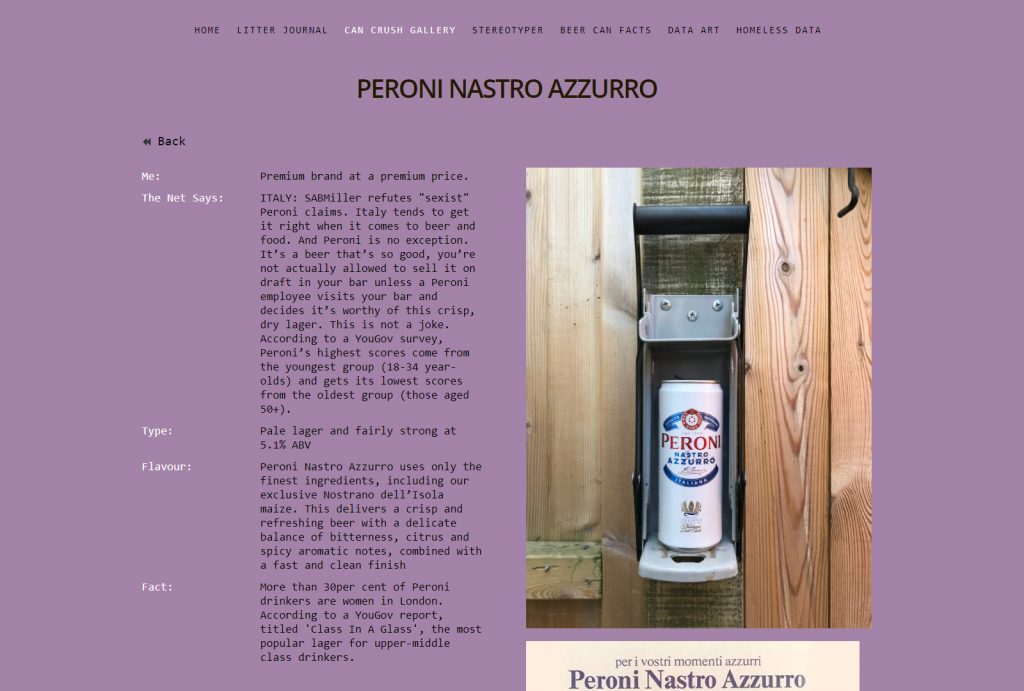Object Identity
1st May, 2020


View my new artwork: Object Identity
Much of my practice is informed by research of related environmental issues such as global warming, extinction and pollution but also cultural issues of the ‘throw-away society’, over-consumption, consumerism, littering and not caring for the rest of society. For this project, I decided to take a common and perhaps banal readymade object, an aluminium beer can, as a starting point and attempt to see it in a new way.
Why A Beer Can?
As a MA Fine Art student, a bottle of beer or a trip to the pub is now a luxury whereas canned beer, which is often on offer in most supermarkets, is a cheaper option. And at a recent gathering of friends and family, someone questioned why I was drinking canned beer (from a glass) and not my usual varied selection of bottled real ales – I explained that it was because I am a full-time student and needs must. This prompted a discussion about what other people were drinking and why would someone drink Fosters or Coors light – they will drink anything. This in turn brought up the question of gender, cultural and social stereotypes. Are you a hipster because you drink craft beer? What if you consume Special Brew or Tenants Extra, both of which are synonymous with homeless drinkers and nicknamed Tramps Juice by the media? Especially, when you consider Special Brew was originally created in Holland to celebrate a visit by Winston Churchill and incorporated the flavour of his favourite cognac – a fact that Waitrose played upon when they tried to target a more affluent audience.
Questions
- Can a beer can be used as metaphor or symbol for consumerism?
- Could an artwork based on a beer be, as Baudrillard philosophies, too hyper-real?
- How does a beer brand relate to stereotypes and demographics?
- How does it relate to consumerism and the throw-away society?
- How are beer memes used to reinforce or parody stereotypes?
- Judge what we have drank what does it say about us?
- Does the choice of consumed cans I collected, from social gatherings at my house, say something about my friends, family and myself?
- How is a can recycled – what if crush it?
- By crushing the can has it been transformed and its ‘form’ changed?
Practice Research
I will explore through practice how an object can be a metaphor but a metaphor in turn can be used to reinforce stereotypes. Even the idea of can or pile of empty cans is evidence for happening such as, a gathering or a celebration. And, depending on where they are found or what brand they are, whether it is in recycling bin or as a pile in the street, could say something about who consumed them. Moreover, collecting statistical data so much easier to find on the internet – a few clicks and you have a detailed report. Furthermore, memes and infographics are often used on the internet, especially social media, to mock or parody by social, cultural or gender types. And, although memes and infographics existed long before the internet it is now much easier to share within online groups of likeminded individuals and therefore, reinforce stereotypes.
However, my intention is to also create a body of work that reflects the time I live in and this includes exploring contemporary ideas of the New Aesthetic, glitch and post-digital art which often deals with how the digital world is taking on a power of its own and spilling over into real life.
“From the ethnographic material available, it is clear that in all cultures where more than one type of alcoholic beverage is available, drinks are classified in terms of their social meaning, and the classification of drinks is used to define the social world. Few, if any, alcoholic beverages are ‘socially neutral’: every drink is loaded with symbolic meaning, every drink conveys a message. Alcohol is a symbolic vehicle for identifying, describing, constructing and manipulating cultural systems, values, interpersonal relationships, behavioural norms and expectations. Choice of beverage is rarely a matter of personal taste.” (SIRC, Social Issues Research Centre, 1998, Social and Cultural Aspects of Drinking)